Bulletin – September 2013 Global Economy East Asian Corporate Bond Markets
- Download the article 578KB
Abstract
East Asian corporate bond markets have grown significantly over the past decade. The expansion of these markets has been underpinned by strong economic growth and regulatory initiatives that have helped to improve market infrastructure and encourage participation. These developments have helped corporations to diversify their funding and are likely to have played a part in supporting the economies in the region during the global financial crisis.
Introduction
Corporate bond markets have a number of important economic functions. For investors, corporate bonds offer long-term, fixed interest returns that can provide portfolio diversification benefits. For issuers, corporate bonds can enable firms to access funding for longer durations than may be available from alternative sources. This helps them to better match their liabilities with the maturities of assets being funded, lowering refinancing risk. Non-financial corporations can also issue bonds to reduce their overall reliance on intermediated financing, which may be harder to access in times of banking sector stress. As an alternative funding source to intermediated credit or equity financing, bonds can help issuers to lower the cost of capital, and local currency bonds also have the added advantage of reducing corporations’ exposures to foreign exchange risks.[1]
It has been widely recognised that the absence of well-developed corporate bond markets contributed to the build-up of maturity and foreign currency risks that exacerbated the 1997–1998 Asian financial crisis.[2] In particular, the lack of such markets meant that strong capital inflows leading up to the crisis tended to be in the form of short-term foreign currency loans that were intermediated through the banking sector. The rapid reversal of these flows, and associated exchange rate depreciations, precipitated extreme pressure on the corporate and banking sectors and a sharp contraction in economic activity.
Accordingly, a key part of Asian regulators' efforts to strengthen financial stability and encourage sustainable growth since the Asian financial crisis has been to develop local currency corporate bond markets across the region. These have included efforts – at both an individual economy and regional level – to improve market infrastructure, lower issuance costs and promote investor participation.
As a result of these efforts, east Asian corporate bond markets have grown significantly since the turn of the century, in terms of both values and relative to gross domestic product (GDP). There have also been significant improvements to market infrastructure, such as clearing and settlement facilities and legal frameworks. In addition, governments have worked to improve liquidity in government bond markets, in part to improve pricing benchmarks for corporate issuance.
At the same time, some aspects of Asian corporate bond markets are still relatively immature. In particular, most local currency corporate bonds in east Asia are held by a small number of domestic institutional investors that have similar buy-and-hold investment strategies, thereby constraining liquidity. A lack of market-making activity also weighs on liquidity, which is related in part to a lack of depth in the markets for hedging instruments and a tendency for private placements in some markets.
Market Size and Growth
East Asian corporate bond markets have grown significantly since the start of the century.[3] The value of corporate bonds outstanding in Asia has risen fivefold over this period, to around US$3 trillion (Graph 1).[4] Relative to GDP, the stock of Asian corporate bonds outstanding has also increased – from 16 per cent in 2000 to 24 per cent in 2012.
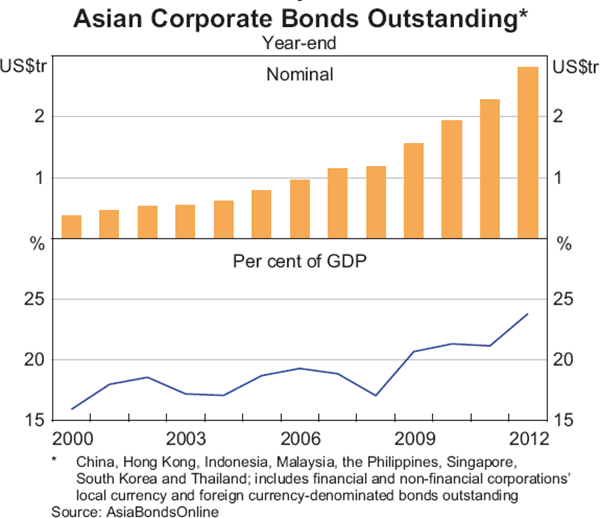
This aggregate figure masks considerable diversity across economies. Corporate bond markets are larger as a share of GDP in the more advanced economies of Hong Kong, Singapore and Korea, whose bond markets are similarly sized to those of developed economies (which range in size from 40 per cent of GDP up to 100 per cent or more; Graph 2). Malaysia's bond market is also relatively large; it benefited from public and industry initiatives in the 1990s and early 2000s, as well as the importance of Malaysia as a centre for issuing and trading Islamic bonds.[5] In contrast, corporate bond markets in Indonesia and the Philippines remain very small, and below the size of markets in a number of other emerging economies.[6]

Bond markets have increased at a considerably faster rate than GDP in many east Asian economies over the past seven years or so. The Korean market grew particularly strongly between 2005 and 2012, though some of this reversed a decline in the corporate bond market in the few years following the emergence of an accounting scandal and credit card company insolvencies in 2003.[7]
The growth in east Asian corporate bond markets has also outpaced growth in intermediated credit, allowing non-financial corporations to diversify funding away from intermediated markets. This has been most evident in economies that have experienced faster rates of corporate bond market growth in recent years; in particular, the share of total corporate debt from sources other than financial intermediaries has increased significantly in China, Korea and Taiwan (Graph 3). Almost one-half of Korean corporations' net debt funding has been sourced from bond markets in recent years, while Malaysian, Taiwanese and Thai corporations also source a sizeable share of their funding needs directly from investors.
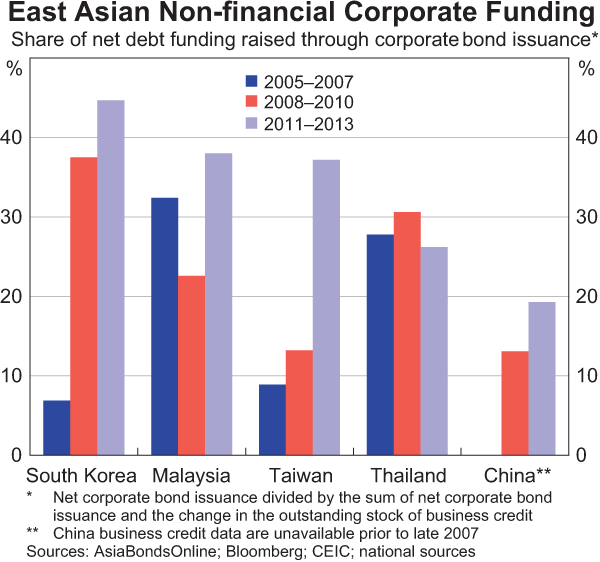
Issuance Characteristics
East Asian corporations issued about US$700 billion of bonds in 2012, compared with just US$40 billion in 2000 (Graph 4).[8] The increase in issuance has been most noticeable in China. In fact, issuance by Chinese corporations accounted for around two-thirds of all east Asian corporation issuance in 2012, up from about one-third in 2007 and close to none in 2000. Issuance by corporations in Korea, Malaysia and Thailand has also increased strongly in recent years. In contrast, issuance in Indonesia and the Philippines remains relatively subdued and has been limited to a small number of borrowers. Issuance by corporations from the financial centres of Hong Kong and Singapore has increased in recent years, with very strong issuance in 2012.
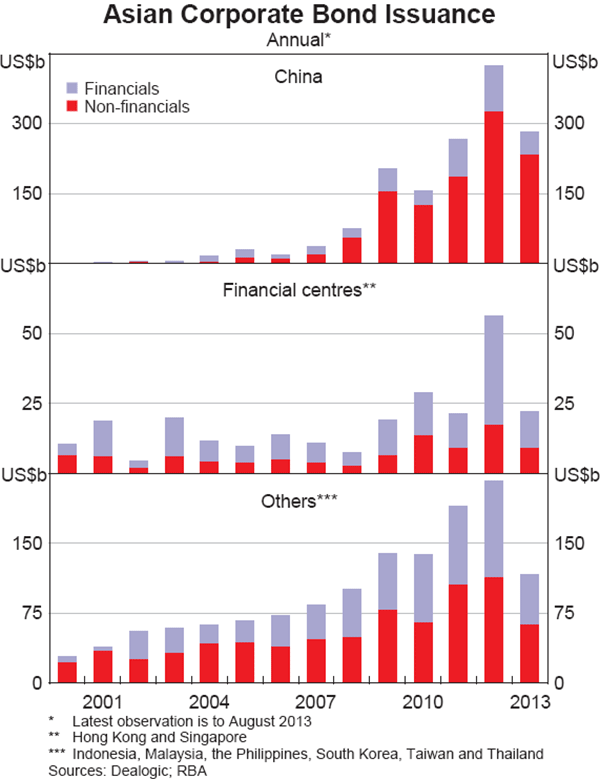
Financial corporations in east Asia generally account for less than half of total corporate bond issuance, though the share in China is smaller at around 20 per cent. Overall, this is a low share compared with most developed markets – where financial corporations typically account for around 70 per cent of corporate issuance – as Asian banks use more deposit funding. The exception to this is in the financial centres of Hong Kong and Singapore, where around 60 per cent of corporate bond issuance is by financial corporations.
Among non-financial corporations, issuance has been most prominent across the region in the construction, real estate, transport, utilities and energy sectors, which tend to have large capital expenditure needs for long-term infrastructure projects that are well suited to bond financing. Issuance by large conglomerate holding companies has also been prominent in a number of economies.
Currency
Outside of the financial centres, the vast majority of Asian corporate bonds are issued in domestic markets and are denominated in local currencies, with non-financial corporations tending to issue a slightly higher share of local currency bonds than financial corporations, particularly in recent years (Graph 5). In contrast, less than half of corporate bond issuance in other emerging markets are denominated in the local currency. The higher share of local currency issuance in east Asia relative to other emerging markets is consistent with regulatory initiatives that have been implemented across the region to develop local currency markets together with high rates of saving in the region. Nonetheless, foreign-currency issuance has also picked up over recent years. This possibly reflects strong demand by foreigners for high-yielding fixed income securities that do not directly expose them to foreign currency risk, as well as an increase in the ability of issuers to hedge their currency risk. Intraregional issuance – issuance by Asian firms into non-resident Asian bond markets – remains limited, although the extent of yuan-denominated bonds issued outside of China (primarily in Hong Kong) has increased from a low level in recent years.[9]
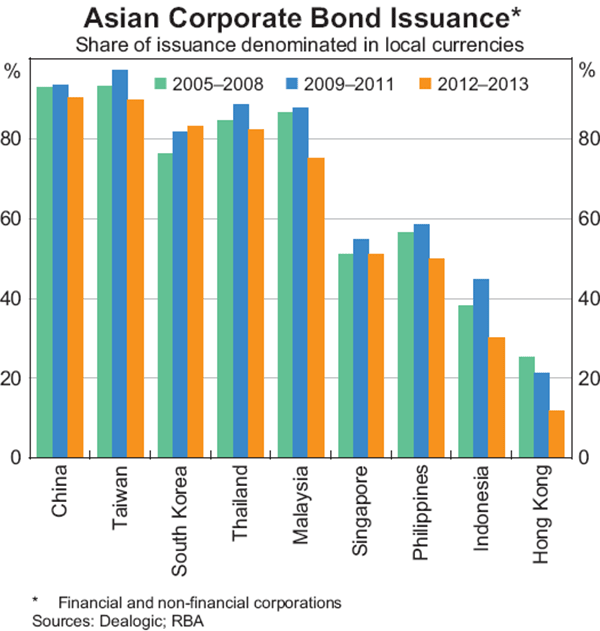
Concentration
A common criticism of Asian corporate bond markets is that issuance is dominated by a small number of corporations. Although this is perhaps true in some smaller markets in the region, such as Indonesia and the Philippines, most other markets appear as diversified as larger, more developed markets (Table 1). That said, publicly owned entities account for a high share of corporate issuance in east Asian economies. This share is typically around 40 per cent in most markets across the region, well above the single digits recorded in most developed markets. In China, the share of corporate bond issuance by publicly owned entities is even higher, at around 80 per cent, partly due to strong issuance by local government financing vehicles in recent years (known as ‘Chengtou’ bonds).[10] Regulators in east Asia have introduced a number of measures to increase market accessibility for smaller corporations, which are more likely to be privately owned, though these measures are yet to bear much fruit.
| Largest 5 issuers | Largest 20 issuers | |
|---|---|---|
| China | 14 | 27 |
| South Korea | 23 | 47 |
| Malaysia | 27 | 64 |
| Hong Kong | 30 | 68 |
| Thailand | 39 | 77 |
| Singapore | 41 | 74 |
| Taiwan | 44 | 81 |
| Indonesia | 53 | 89 |
| Philippines | 51 | 99 |
| Memo items | ||
| United States | 10 | 22 |
| Japan | 31 | 55 |
| Canada | 43 | 64 |
| Australia | 62 | 85 |
|
Sources: Dealogic; RBA |
||
Credit ratings
Although most east Asian bond markets require publicly issued bonds to be rated at issuance, no ratings information is readily available for a large share of Asian corporate bond issuance (Graph 6). This is partly due to the preference of Asian corporations in some markets to initiate bond funding via private placements, as issuing bonds into public markets has more burdensome regulatory, reporting and disclosure requirements.[11] Of those that are rated, the available information from local ratings agencies suggests that the vast majority of outstanding corporate bonds are investment grade.[12] Consistent with the predominance of investment grade issuance, the incidence of corporate bond defaults in Asia has been low in recent years. Despite the limited availability of Asian corporate credit ratings data, the presence of local credit ratings agencies has expanded in recent years. This has been encouraged by governments and market participants across the region, reflecting a view that local agencies are well placed to access information and develop an understanding of issues particularly relevant to Asian financial markets. Private sector initiatives, such as affiliate relationships with major international ratings agencies and the development of the Association of Credit Rating Agencies in Asia (ACRAA), have also supported the development of credit ratings agencies and credit ratings standards in Asia.
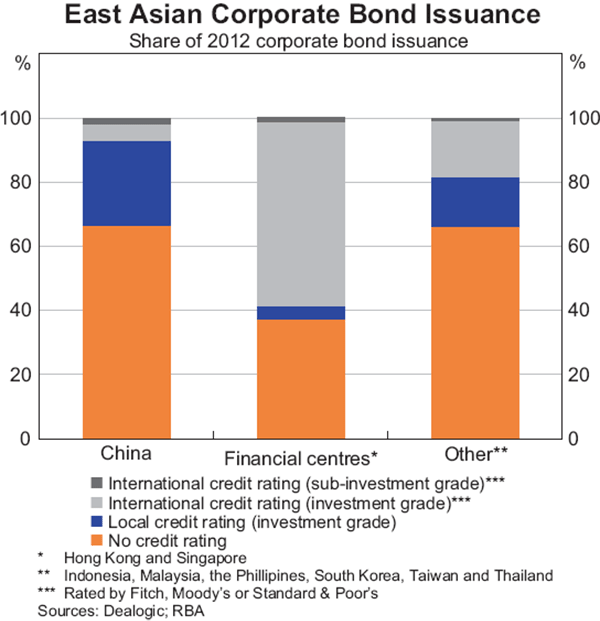
Tenor
The average maturity of Asian corporate bond issuance is around six years, with corporations generally able to issue offshore at longer maturities than in local currency markets. The average length to maturity at issuance has increased over time as corporations have issued a greater share of bonds at tenors of three years or more (Graph 7). The main exception is in China, where there has been a significant increase in issuance of shorter-duration bonds following the People's Bank of China's 2008 decision to allow rated non-financial corporate entities to issue medium-term notes (MTNs) on the over-the-counter market. MTNs have been attractive to borrowers as they are not subject to borrowing caps or the stringent approval process associated with regular corporate bond issuance. The strong pick-up in MTN issuance has resulted in the average tenor of Chinese non-financial corporations' bond issuance falling slightly below that of financial corporations; in contrast, the average tenor of non-financial corporate bond issuance is longer than for financial corporations in most other east Asian markets.
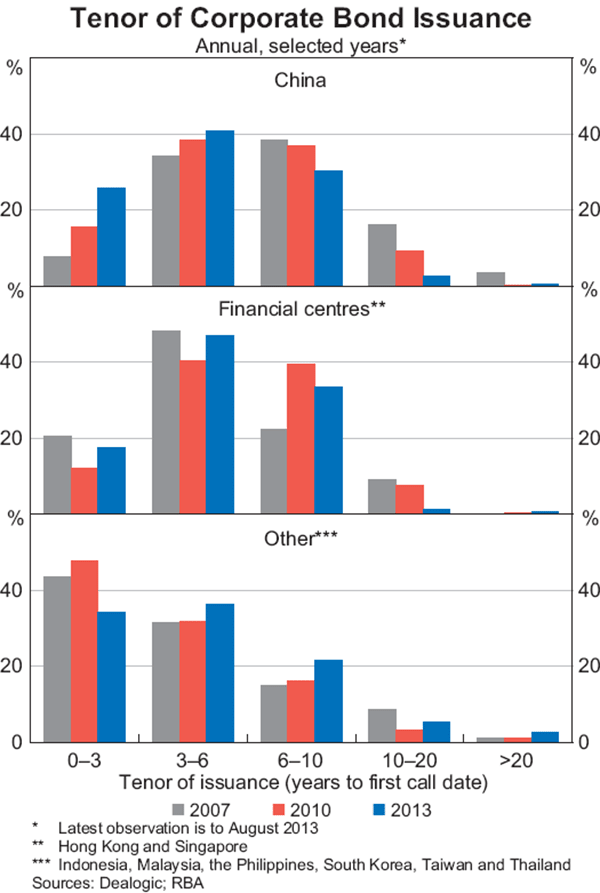
Structures
Most bonds issued in the region operate under a standard fixed-rate coupon structure, though a broader range of structures has been issued in recent years. This includes zero coupon bonds, standard and reverse floating rate bonds, dual-currency bonds, step-up notes and hybrid instruments. The availability of asset-backed securities (ABS) remains limited, owing to low demand for this more sophisticated instrument as well as a lack of specific legal and regulatory frameworks and market infrastructure. ABS issuance in the region is concentrated in Korea. The covered bond market is also in its infancy, with Korea being the first jurisdiction in the region to pass enabling legislation in January 2013.[13]
Ownership and Liquidity
Domestic institutional investors are the largest group of corporate bond holders in most Asian markets. Local banks, insurance firms and pension funds tend to be the dominant participants in this category (holding around 90 per cent of corporate bonds outstanding in China, and half of corporate bonds outstanding in Korea). Investment by other types of domestic institutional investors – such as mutual funds and exchange-traded funds (ETFs) – remains relatively limited. Thailand is a notable exception, where mutual funds are more active and hold around 10 per cent of outstanding local currency corporate bonds. Direct investment by individuals is low in most economies, other than in Thailand where individuals' holdings currently account for around half of all corporate bonds outstanding (with issuance commonly distributed through branches of the underwriting banks).
Foreigners do not currently hold many local currency corporate bonds in east Asia. For example, foreigners hold just 1 per cent of local currency-denominated corporate bonds outstanding in Korea. In China, the share is even lower with foreigners having only very limited access to Chinese debt securities via the Qualified Foreign Institutional Investor and RMB Qualified Foreign Institutional Investor programs.
The primary reason for the limited involvement of foreigners appears to be their concerns about having dual exposures to foreign currency risk and emerging market corporate credit risk. Nonetheless, foreign holdings of local currency bonds issued by governments in east Asia have increased significantly over recent years. However, market reports indicate that foreign investors are much more active in foreign currency-denominated Asian corporate bond markets (mostly US dollar-denominated bonds) than in local currency corporate bond markets. Foreign currency-denominated east Asian corporate debt is appealing to foreign investors due to the availability of replicable portfolio benchmarks (such as JPMorgan's CEMBI Index), larger deal sizes, and a greater likelihood that they are rated by an international ratings agency.
Asian authorities have introduced measures to improve foreigners' access to local currency debt markets over recent years. These include some loosening in restrictions on capital flows, improvements in foreign currency convertibility and an easing in foreign investor registration requirements. However, some impediments to foreign access remain, including withholding taxes and the limited availability of credit derivatives and foreign exchange hedging instruments. Prior to the global financial crisis, credit default swaps (CDS) were used increasingly by foreign investors as a hedging tool as well as a means for obtaining exposure to Asian corporate credit risk, though CDS market liquidity has since declined significantly.
The narrow investor base in local currency corporate bond markets is widely cited as a constraint on secondary market liquidity (ADB 2013). While bid-ask spreads and turnover ratios for corporate bonds in some east Asian markets are broadly comparable to those in more developed markets, the limited number of domestic institutional investors participating in local currency east Asian corporate bond markets all tend to have similar buy-and-hold investment strategies. This constrains secondary market depth and can contribute to prices moving by large amounts in response to orders. In general, turnover is also limited to the first month or two after a bond is issued. Limited market-making activity also constrains liquidity, which is in part due to a lack of depth in the markets for hedging instruments as well as a tendency for private placements in some markets (which are typically sold directly to a small number of investors). Some authorities have recently tried to make improvements on this front; for example, the Monetary Authority of Singapore announced in 2012 that it will purchase corporate securities and make them available for securities lending in an effort to boost market-making activity in the corporate bond market.
Efforts to Facilitate the Growth in Bond Markets
A number of multilateral initiatives were established in the years after the Asian financial crisis to enhance the development of local financial markets across the region. In 2003 and 2004, the Executives' Meeting of East Asia-Pacific Central Banks (EMEAP) established the Asian Bond Funds 1 and 2 (ABF 1 and 2), which were designed to promote the development of regional bond markets and retain investment of some of the region's foreign currency reserves locally.[14] The ABFs have also promoted private sector participation in local currency bond markets by enhancing information disclosures and governance standards, with ongoing monitoring undertaken by the EMEAP Working Group on Financial Markets. Around the same time, the Asian Development Bank, together with the Association of Southeast Asian Nations (ASEAN) and the Japanese and Chinese Governments – collectively known as ASEAN+3 – established the Asian Bond Markets Initiative (ABMI) to promote the development of local currency bond markets, improve bond market functioning and increase market accessibility to issuers and investors. The scope of the ABMI's work has expanded in recent years with the release of a new ‘road map’ in May 2008 and the establishment of the Asian Bond Market Forum (ABMF) in 2010 to foster standardisation of market practices and harmonisation of regulations relating to regional cross-border bond transactions.
Individual governments have also worked to encourage bond market development. For example, a number of economies have focused on improving liquidity across government bond yield curves to provide more reliable risk-free pricing benchmarks for corporate bonds.[15] Governments have endeavoured to improve market infrastructure, with significant enhancements achieved in the efficiency of clearing and settlement systems; the vast majority of corporate bonds have moved to scripless form and trade via electronic book entry using delivery versus payment settlement.[16] Sophisticated post-trade infrastructures have also been implemented in a range of economies, such as Korea, Malaysia and Thailand. In addition, burdensome issuance and registration requirements have been eliminated or reduced across the region.
Other efforts have focused directly on expanding the investor base. For example, a number of jurisdictions have tried to encourage foreign investment by loosening restrictions on their involvement and reducing withholding taxes. More broadly, governments have also worked to improve transparency, particularly by enhancing disclosure and reporting standards.[17] In many cases, legal frameworks, especially laws relating to bankruptcy procedures, have been strengthened.
In addition to efforts by governments, industry initiatives have also facilitated bond market growth. These include the self-regulatory organisations and other market participants involved in the ABMF, and the expansion of the ACRAA.[18]
Resilience during the Global Financial Crisis
Since the intention of building up corporate bond markets has been to increase the resilience of east Asian economies in the face of financial shocks, it is worth considering how these markets fared in the face of the global shock to the financial system in 2008. While this shock was centred in advanced economies outside of Asia, it was associated with a sharp reversal of portfolio capital inflows to the east Asian region during 2008 and early 2009 (Graph 8). It is notable that the volumes of corporate bonds issued in most east Asian economies were little affected during this period, as an increase in local currency bond issuance offset a decline in foreign currency bond issuance as issuers refocused on selling to domestic investors. This resilience helped to support corporations' access to funding (and financial stability, more broadly) at a time of acute stress in global financial markets and reduced access to bank funding (particularly as international lenders, especially European banks, pared back their lending activities).
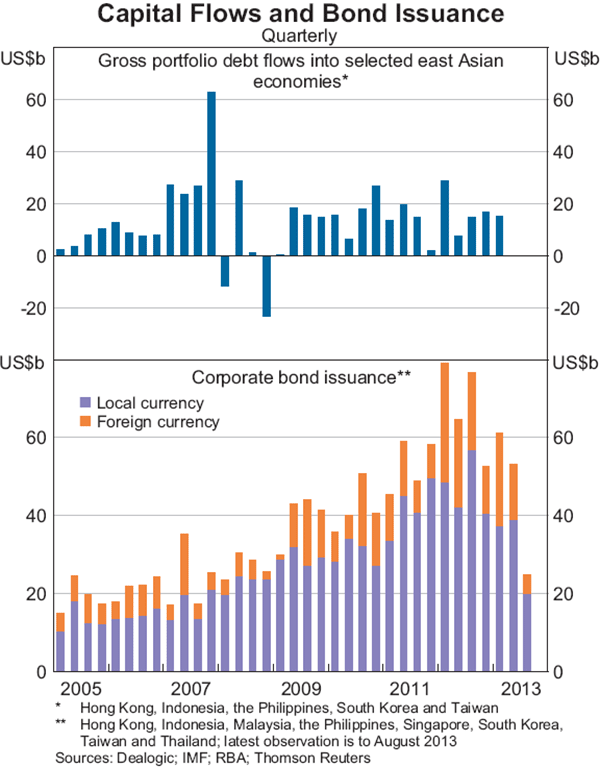
Conclusion
Asian corporate bond markets have grown significantly since the turn of the century, underpinned by strong economic growth and regulatory initiatives that have helped to improve bond market infrastructure. The growth of these markets has occurred in response to the recognition that excessive reliance on intermediated credit was a key source of vulnerability during the Asian financial crisis, and it is likely that the growth and increased sophistication of these markets played a role in enabling the region to quickly recover from the global financial crisis.
Footnotes
The authors completed this work in International Department. [*]
For more discussion on the benefits of bond market development, see RBA (2003). [1]
For a more detailed account of the 1997–1998 Asian financial crisis, see Stevens (2007). [2]
The east Asian economies referred to in this article are China; the financial centres of Hong Kong and Singapore; as well as ‘others’, which covers Indonesia, Malaysia, the Philippines, South Korea, Taiwan and Thailand. We exclude Japan, whose corporate bond market has a long history and is well established. In this article, corporate bonds include debt securities issued by the private sector and state-owned corporations. [3]
This figure is based on data from AsiaBondsOnline, which are compiled using individual national sources and include short-term notes and debt securities issued by non-residents. Other sources on the size of Asian bond markets provide different estimates, but overall trends are consistent with the AsiaBondsOnline data. [4]
Initiatives included the establishment of credit ratings agencies in the early 1990s, the Bond Dealers Association in 1996, the introduction of real-time gross settlements in 1999 and a disclosure-based regulatory framework in 2000. For more information, see bin Ibrahim and Wong (2006). [5]
By way of comparison, equity market capitalisation in the east Asian economies is around 30–60 per cent of GDP. This share is typically smaller than developed economies' equity markets (which range from around 80 to well over 100 per cent of GDP), but broadly in line with other large emerging markets. The main exceptions are Hong Kong, which has the largest equity market relative to economic activity in the region, at around 90 per cent of GDP, while China's equity market, similar to its bond market, remains relatively small at about 20 per cent of GDP. [6]
For more information on the causes of this decline, see Lee and Kim (2006). [7]
Issuance data are sourced from Dealogic's Debt Capital Markets database and are based on nationality of the issuing entities' parent companies. Results are little changed if issuance data are aggregated based on the issuing entities' residencies. Bonds are defined as debt securities (excluding money market securities) with an initial term to final legal maturity of greater than one year. [8]
For more information, see Ballantyne, Garner and Wright (2013). [9]
Under China's budget law of 1994, local governments must maintain a balanced budget and are not permitted to issue bonds themselves (although a handful of local governments have been given permission to issue bonds in trial programs). [10]
The Asian Bond Markets Forum has identified the ‘regulatory vacuum in private placement’ in some markets as an area for future reform. See ADB (2012). [11]
For example, sub-investment grade issuers account for less than 5 per cent of rated corporate bonds issued in Malaysia and Thailand and less than 10 per cent of corporate issuance in the Philippines. In comparison, around 30 per cent of corporate bond issuance by US corporations is rated sub-investment grade by major international credit ratings agencies, while in other developed markets the share of sub-investment corporate bond issuance ranges from low single digits to around 15 per cent, with the share in Australia at the lower end of the range. [12]
The Monetary Authority of Singapore released a consultation paper on covered bond issuance in March 2012, but is yet to release final guidelines. See MAS (2012). [13]
The ABF 1 was launched in July 2003 and invested US$1 billion in US dollar-denominated bonds issued by sovereign and quasi-sovereign entities in eight of the eleven EMEAP economies (excluding Australia, Japan and New Zealand). The ABF 2, launched in December 2004, invested US$2 billion in local currency-denominated bonds issued by sovereign and quasi-sovereign entities from the same eight EMEAP economies. [14]
Efforts include the introduction of a pre-announced schedule of issuance, the concentration of bond issuance at key points along the yield curve, the establishment of a primary dealer group for government securities and buyback operations. [15]
Delivery versus payment is a settlement method that ensures delivery occurs if and only if payment occurs, which reduces settlement risk. [16]
In Malaysia, Korea and Thailand, all trades are required to be reported to industry associations within 10, 15 and 30 minutes, respectively. [17]
Self-regulatory organisations are market bodies such as exchanges or industry associations that set and enforce market rules and standards. Examples include the National Association of Financial Market Institutional Investors in China, the Korea Financial Investment Association and the Thai Bond Market Association. [18]
References
ADB (Asian Development Bank) (2012), ASEAN+3 Bond Markets Guide, Asian Development Bank, Manila.
ADB (2013), Broadening the Investor Base for Local Currency Bonds in ASEAN+2 Countries, Asian Development Bank, Manila.
Ballantyne A, M Garner and M Wright (2013), ‘Developments in Renminbi Internationalisation’, RBA Bulletin, June, pp 65–74.
bin Ibrahim M and A Wong (2006), ‘The Corporate Bond Market in Malaysia’, in Developing Corporate Bond Markets in Asia, BIS Paper No 26, Bank for International Settlements, Basel, pp 114–128.
Lee M and S Kim (2006), ‘Developing the Corporate Bond Market: The Korean Experience’, in Developing Corporate Bond Markets in Asia, BIS Paper No 26, Bank for International Settlements, Basel, pp 96–113.
MAS (Monetary Authority of Singapore) (2012), ‘Consultation Paper on Covered Bond Issuance by Banks Incorporated in Singapore’, P006-2012, March. Available at <http://www.mas.gov.sg/~/media/resource/publications/consult_papers/2012/9%20March%202012%20Covered%20Bonds%20Issuance%20by%20Banks%20 Incorporated%20in%20Singapore.pdf>.
RBA (Reserve Bank of Australia) (2003), ‘Bond Market Development in East Asia’, RBA Bulletin, December, pp 1–8.
Stevens G (2007), ‘The Asian Crisis: A Retrospective’, RBA Bulletin, August, pp 65–76.